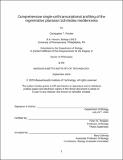| dc.contributor.advisor | Peter W. Reddien. | en_US |
| dc.contributor.author | Fincher, Christopher T.(Christopher Terry) | en_US |
| dc.contributor.other | Massachusetts Institute of Technology. Department of Biology. | en_US |
| dc.date.accessioned | 2021-01-05T23:15:37Z | |
| dc.date.available | 2021-01-05T23:15:37Z | |
| dc.date.copyright | 2020 | en_US |
| dc.date.issued | 2020 | en_US |
| dc.identifier.uri | https://hdl.handle.net/1721.1/129053 | |
| dc.description | Thesis: Ph. D., Massachusetts Institute of Technology, Department of Biology, 2020 | en_US |
| dc.description | Cataloged from student-submitted PDF of thesis. | en_US |
| dc.description | Includes bibliographical references. | en_US |
| dc.description.abstract | Animals can contain hundreds of cell types, each of which has a distinct morphology and function. The transcriptome of a cell dictates this unique cell biology. Recent approaches for high throughput single-cell RNA sequencing have made it possible to generate transcriptomes easily and affordably for tens of thousands of single cells, raising the possibility that transcriptomes could be generated for all cell types and cell states in a complete animal. Planarians are freshwater flatworms renowned for their capacity for whole-body regeneration. They possess a complex body plan with multiple distinct tissues. They also possess a population of dividing cells, called neoblasts, which contain pluripotent stem cells and are the source of all new tissue, with all cell types being turned over throughout the life of the animal. Planarians also constitutively express an arrangement of regionally expressed genes in their muscle that serve as patterning information for the animal. | en_US |
| dc.description.abstract | As such, at a single time point in the adult, pluripotent stem cells, all differentiated cells, and all associated transition states from stem cell to differentiated cell can be recovered, including patterning information expressed in muscle. This makes planarians ideally suited to generating an atlas of transcriptomes for all cell types and cell states in a whole animal. We used the single- cell RNA sequencing technology Drop-seq to determine the transcriptomes for 66,783 cells from adult planarians. In doing so, we identified a number of known and novel cell populations, including a novel class of phagocytic cells. We also uncovered novel neoblast subpopulations and putative transition state populations between neoblasts and differentiated cells, as well as a number of genes with regional expression in muscle. | en_US |
| dc.description.abstract | Through the identification of known rare cell types in the data, we conclude that we have obtained near-to-complete cell type saturation for all cell types and cell states in the adult planarian. We now have full transcriptomes for each of these cell populations, which can be utilized to assay their roles in planarian biology. This approach can also be applied widely to diverse animal species, including those with limited molecular tools available. | en_US |
| dc.description.statementofresponsibility | by Christopher T. Fincher. | en_US |
| dc.format.extent | 237 pages | en_US |
| dc.language.iso | eng | en_US |
| dc.publisher | Massachusetts Institute of Technology | en_US |
| dc.rights | MIT theses may be protected by copyright. Please reuse MIT thesis content according to the MIT Libraries Permissions Policy, which is available through the URL provided. | en_US |
| dc.rights.uri | http://dspace.mit.edu/handle/1721.1/7582 | en_US |
| dc.subject | Biology. | en_US |
| dc.title | Comprehensive single-cell transcriptional profiling of the regenerative planarian Schmidtea mediterranea | en_US |
| dc.type | Thesis | en_US |
| dc.description.degree | Ph. D. | en_US |
| dc.contributor.department | Massachusetts Institute of Technology. Department of Biology | en_US |
| dc.identifier.oclc | 1227031302 | en_US |
| dc.description.collection | Ph.D. Massachusetts Institute of Technology, Department of Biology | en_US |
| dspace.imported | 2021-01-05T23:15:36Z | en_US |
| mit.thesis.degree | Doctoral | en_US |
| mit.thesis.department | Bio | en_US |
